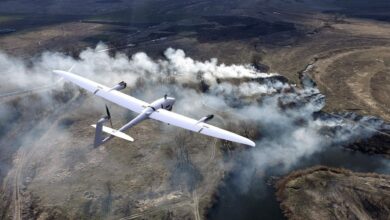UK Marines Test ‘Throwbots’ Lobbed Inside Buildings
The lightweight reconnaissance robot are sturdy enough to survive a fall of up to 30 feet.
The UK Royal Marines recently tested a lightweight reconnaissance robot that can be lobbed over walls or into a building to get live footage of what’s going on inside the structure.
The Scotland-based 43 Commando Fleet Protection Group used the hand-sized “throwbots” as part of an exercise to protect the nation’s nuclear arsenal at the Clyde naval base.
#RoyalMarines of @43Commando have rolled out new kit as they honed the skills vital to their no-fail mission protecting the nation’s nuclear deterrent on exercises in Gibraltar. #FutureCommandoForce
Read more: https://t.co/gzyNmdT59D pic.twitter.com/ENGfRQvGbD
— Royal Marines (@RoyalMarines) November 13, 2020
The two-week exercise saw 80 marines carry out amphibious operations, cliff assaults, and close-quarters combat training in which the remotely-operated robots, along with some other futuristic devices, were tested to determine their operational compatibility.
Can Survive 30 Minutes Underwater
The “throwbots” are sturdy enough to survive a fall of up to 30 feet and automatically self-right as soon as they land on the ground, the Daily Mail wrote, adding that they can survive being submerged in water up to three feet (1m) deep for 30 minutes.
Each device costs 5,000 pounds ($6,600), the website wrote, citing the Ministry of Defence.
“The ‘Throwbot’ is another system that we can put into confined spaces. We can steer it remotely to understand the shape and size of confined spaces and identify any threats,” said Major Tom Baybutt, the Officer Commanding P-Squadron of 43 Commando.
The equipment is designed to give the marine and tactical commandos on the ground an edge over their adversary in situational awareness to make decisions better and more quickly.
RPAS Drones
The exercise also saw the use of Remotely Piloted Aerial Systems (RPAS) drones.
“The RPAS were put to good use, with the marines flying them at night and then scaling cliffs to assault the objective. Using the drones allowed us to work out the best method of entry to the target and the number of adversaries on the ground,” Baybutt said.
The Android Team Awareness Kit (ATAK), a computer tablet to help the soldiers navigate, and a ballistic shield for individual protection in confined spaces were also used in the exercise.
“We’ve been using the ATAK to give the commanders on the ground enhanced situational awareness. It’s a system that allows us to track everyone and manage the battlespace more effectively,” said Baybutt.
“We’ve also got ballistic shields which offer the marines a lot more protection going through confined spaces, moving forward as they engage the adversary, that’s worked particularly well in the tunnels.”












